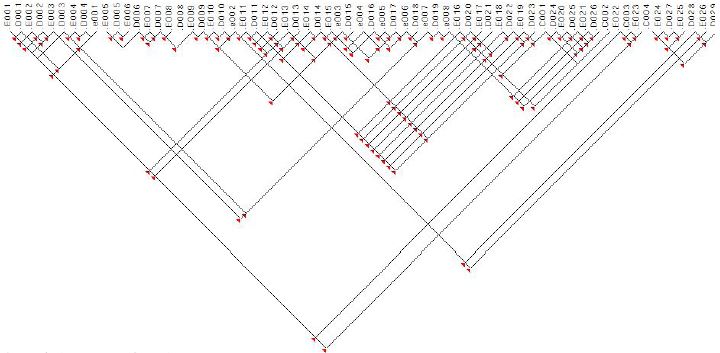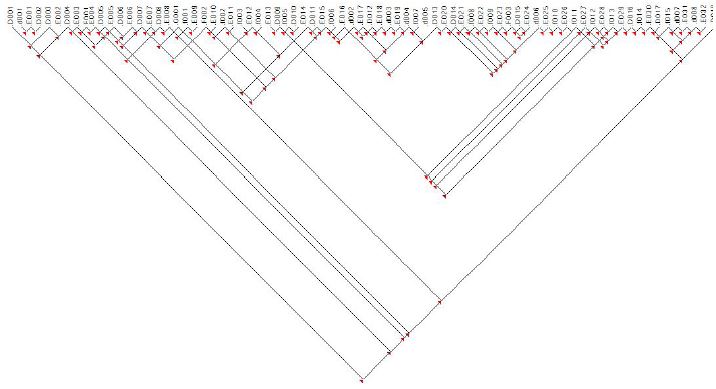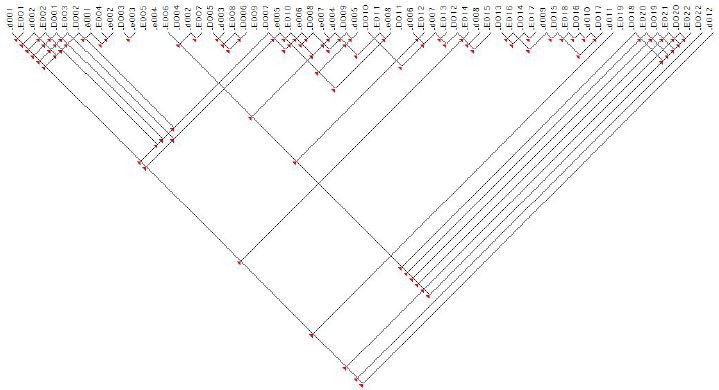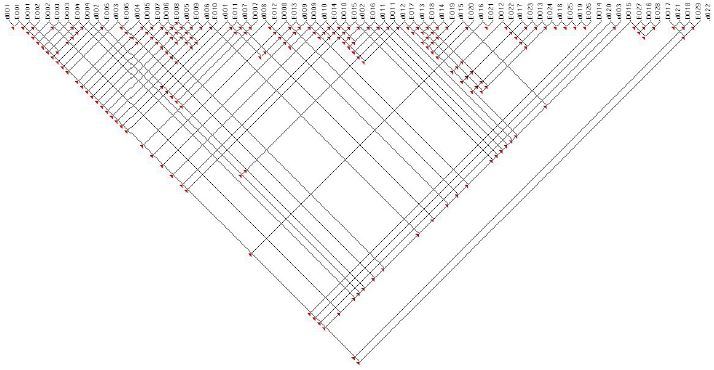
Factors for Creative Collaboration of Industrial Designers and Engineers
Background To satisfy the customers’ emotional as well as material desires, industrial design requires collaborative activities with other areas of profession such as engineering, marketing and so on. The focus of this study is to investigate possible conditions to minimize the conflicting impacts so as to allow more creative collaborations in designer-engineer teamwork.
Methods The study applied Goldschmidts’ Linkograghy with Shannon’s Entropy Theory to analyze the teamwork sessions of industrial designers and engineers, and to investigate possible conditions for creative collaborations. Total of five teamwork sessions were observed, recorded and transcribed afterwards. Each transcript was analyzed to draw the linkograph, to measure entropy and to carry out macro/microscopic observations and discussions of each session based on the measurements.
Results As for the result of measurement, the values of Link Index(LI), Back Link(BL) Entropy, Forward Link(FL) Entropy, Horizon Link(HL) Entropy, and Total Entropy were calculated for each session. Critical Moves of each session were found based on LI, and analyzed and discussed how they relate and influence other moves and why. As one of the macroscopic results, session 5 has shown the highest entropy among five sessions taken to be the most creative session. It is interpreted that the existence of the leader in the team and intermediate and directional role of the leader influenced the team dynamics and creativity.
Conclusion The study has shown that the creativity of designer and engineer teamwork enhances when they try to define and understand each others’ terminology, when they try to find solutions for colliding values, when they are composed of members with diverse lengths of work experience, and when there is a leader and her/his strong leadership which leads the team’s conflicting situation to be settled.
Keywords:
Linkography, Linkogragh, Entropy, Collaboration, Team creativity1. Introduction
1. 1. Background of Study
Due to the recent success of products with creative design and functions, companies are focusing their efforts on finding more innovative and creative ideas for their products. In the past, design was simply perceived to be outer appearance on color and shape but in recent trends show that design has become companies' strategic core factor and element that drives the product's competiveness.
Designers are more open to interact with specialists in many different areas where industrial designers and engineers can be perceived as specialist from totally different area of study. However, considering the fact that the product basic characteristics and features are decided through mutual cooperation of these two specialists from beginning stages of product development, company project's success or failure highly depends on the balance and cooperation of industrial designers and engineers. This is why more attention is being given to attaining the best possible results through the teamwork of designers and engineers.
1. 2. Study Goals and Methods
This study aims to use the Linkography to study the cooperation of industrial designers and engineers in the production development process and observe the factors that influence the creative teamwork. Linkography is a tool that has been developed to study the architecture designers' productiveness and creativeness in the early 1990's and has been introduced by Goldschmidt, G. of Technion Israel Institute of Technology.
Linkography still has elements that require enhvancements but has been utilized in this study to analyze the text-based creative observation aspects(Goldschmidt, 1990).
To study the creative activity of teams of designers and engineers, 5 teamwork sessions were observed and recorded which were analyzed through protocol and interpreted through using Linkography. To do this, understanding different characteristics of designers and engineers was required and the study took to careful observation of factors that influence the creative cooperation in the product development stages.
2. Theory Background
2.1. Cooperation of Industrial Designers and Engineers
Cooperation is generally defined as joint effort to sucessfully perform a task or a process to achieve a common goal and it can be segmented in individual, group, enterprise, nation cooperation(Anderson, Narus, 1990).
Most groups cohesiveness tend to grow stronger in internal competition or in outer threatening factors. In case of competition between the two groups or difference of positions, designers and engineers would lean towards their own affliations which in turn can lead to failure of cooperation. This study has interpreted the cooperation of designers and engineers as the teamwork of the two groups to achieve a common goal.
It has been proved that cooperation of design and engineer departments and more that their communication levels are aligned the more it is likely the results are sucessful through various companys' success in the market. The more the two departments are defining and realizing the common problems at hand, and when they are exchanging the information to find the customer's needs, it is more likely the new products in development will have more success rate in the market.(Souder, Chakrabarti,1978)
In past experiences, the departments have difficulty in working as a common team due to the fact that each department tend to give meaning to participation as a common team but rely on their own point of view and opinion when it comes to their behavior for common goal.
In comparing industrial designers and engineers's working characteristics, designers focus on outer appearance and user interface development whereas engineers on product features and its production technology. Designers determine the product concept based on the project on hand with some abstract thought process whereas engineers focus on product production technology, specification, material, durability and technological requirements to define specific and scientific methods in their process. These differences in designers and engineers characteristics come from their training and education which in turn sets their goals in separate ways.
2. 2. Team Creativity
Defining creativity as one collective concept is not easy due to difference of definition from various scholars. Most studies on creativity investigates the relationship of individual education and environment.
According to Torrance(Torrance, 1963), creativity defined as the ability and the process of the effort to newly combine related ideas. According to the study of relationship between teamwork entropy and creative design by Kan and Gero(Kan and Gero, 2005), it was assumed tha creativity is related to the ideas in design process and its internal relation. teamwork with high idea creation show high entropy results and in turn prove to be creative in relation.
This study's goal is to use the entropy levels through Linkography to observe the team creativity and will determine the definition of creativity in the sense of active exchange of ideas in the team.
3. Observation of Creativity through Linkography
3. 1. Linkography
Linkography was first introduced by Goldschmidt(Goldschmidt,1990) to measure the design productivity through design protocol analysis. This study aims to use the Goldschmidt's Linkography as design process of in which ideas occur and compare the relation of factors in team cooperation. Recent studies on creativity attempt to measure and quantify the revelation of creativity which point to Goldschmidt's proposition of specific process of activity to come up with logical pattern gives meaning to the process. Goldschmidt has assumed the following. The conversation within a team that is composed of same area of knowledge and information are small units called move and each move is created in horizontal and in order. Move is the statement of the participant's to express the ideas and all related design concept or project are topics of those moves. In the team sessions, the designers and engineers exchange their opinions(moves) in the process of coming up with the design solutions. This moves continue until the final collection to the solution occurs and all the moves come together to decide on the total session's direction. When the moves are related, they are called 'linked', and are indicated by connecting the two moves. To determine the relation of the link, common sense is used to question and decision is made. Answer is 'Yes/No' and in case of 'Yes', link is made and in case of 'No', no link is made. When the Linkography is completed, the whole design sessions show the moves linked together to form a network of graphics.
Goldschimidt has defined Backlink(BL) and Forelink(FL) as two types of link types in his study. First, backlink shows the course of occurrence of moves through contents that already have taken place in time and forelinke shows the next link related to the move that will occur next which will be the basis on the new move to occur. The move that has the greatest number of backlink or forelink is called Critical Moves. It has been assumed that creativity is related to the links within the moves in the process of design process. The relation of moves can be determined in checking whether the moves all create links between them.
The factors that can be observed through Linkography is as follows.
-Link Index: number of total links by number of moves, the higher the number, the higher the productivity
-important moves and the relation of the ratio
- team members contibution level of the total teamwork
3. 2. Information Theory
Shannon, C.E, who is the creator of Information Theory that utilizes the probalistic method of mathematics, has infered through information and probablity the following theory though the book, A Mathematical Theory of Communication.
As the probability(p) that Information(I) will occur will decrease, the amount of information increases and when probability increase, the amount of information decreases. Shannon has proved the assertion that relationship between the amount of information in a message and the frequency of the message can be calculated in its probability. Therefore, the information amount will decrease when the message is clear and in regularity, and in turn the amount of information will increase with unclear and irregular message. The following definition is defined through this assertion.
The amount of information and probability is in inverse proportion and that relation is linked in logarithm.
Using Shannon's definition on information amount with combination of information called 'entropy', the measurement of communication average information amount has been introduced. The average amount of information in one unit of total session is called entropy(H) and can be defined as below expression.
Kan and Gero has proposed the methology to calculate the entropy level of creativity using Shannon's information theory and Goldschmidt's Linkography.(Kan and Gero 2004). The backlink entropy level, which has been defined in Goldschmidt's Linkography theory, has been developed or emphasized. For example, if an idea in a teamwork is very ordinary and not at all special then the backlink will no longer be created to that idea and will show very low entropy levels as a result. Whereas if an idea has backlinks in the conversations held before, then it will be considered very creative opinion which in turn will show high entropy levels.
In case of forelink, if the idea is relatively low in connection, the idea can be found to be almost without any influence in the conversation and the entropy levels are low. Whereas if the idea has too much forelinks, the flow of the conversation is fixated on that one idea and show that the switch to new ideas in the conversation is not taking place. This will also show low level of entropy levels.
Additionally, the concept of distance and time between the links has been used called Horizonlink which show the relation and potential aspects of gaps between the moves. Low horizonlink entropy level show that the ideas are wholly focused on one move.
(The black dot in Fig.4 show linked) Link and unlinked show the entropy level calculation method. p(linked) is the ratio of links in the total moves. p(unlinked) is the ratio of unlinked total moves. Taking each horizontal entropy levels using the above formula, the calculation comes to as below.
4. Observation Experiment
4. 1. Experiment Method and Contents
For the actual study, observation of teamwork between industrial designers and engineers were taken place. The data for this study is based on the meeting process of designers and engineers of 'A' manufactoring company in Kyonggi Province of Korea. Each Linkography has been drawn up based on analysis of each session. Topic of each session varies but the overall theme of discussion is maintained in discussing the engineering factors of suggestions brought up by designers. Each participant of the session is made up on designers with design related education whereas the engineers hold engineering majors. The experience of each area varies from 2 years of working level to 15 years and the position from assistants to directors.
4. 2. Experiment and Analysis Result
Observation of meeting between each department was done which comprised of total four participants with designer manager of 15 years of experience(D.C) and engineer assistant manager of 7 years of experience(E.e). The meeting was held for 20 minuites. Session1 has been made up of 67 design moves and total of 121 links was progressed which showed link value of 1.806. Backlink entropy value of 0.425, forelink entropy value of 0.270 and horizonlink entropy value showed 0.136. Therefore session1 total entropy average value is 0.831.
Next observation was made through linkography analysis method. D026 had 6 backlinks and this showed to be the crystal move in this session. E001 and D014 has 10 forelinks which is also the crytal moves.
Looking at D026, there is difference in opinion and opposition to the engineer's technical limitation that has been continued from e009 which comprises of the clash of opinion that has been shown throughout. Also, the moves after D026 do not refer to the same contents which can be observed to show that the designer acknowleges the engineer's technical limitations.
The engineer explains that map out plan as reviewed from the start of the session at E001 and this move is the source of ideas in making the whole meeting to progress.
D014 is where the designer expresses the ideas to which the direction of projects needs to be headed. Therefore this part is linked to many conversations with the engineer which follows which show the engineering department either highly opposes or agrees with the designer department.
Total of 3 participants took part in the meeting with designer manager of 15 years of experience(D), engineer assistant manager of 5 years of experience(E), and designer assistant manager of 5 years of experience(C). The meeting was held for 8 minuites. Session 2 had 32 design moves with total of 47 links. The link value showed 1.469 with backlink entropy of 0.281, forelink entropy of 0.356 and horizonlink entropy of 0.187. Therefore the total entropy average value was 0.823.
E008 and E009 had 4 backlinks and are the crystal moves in session 2. D002 had 5 forelinks and it is the crystal move. E008 and E009 are engineer moves that occur around the same time. The idea that design department has referred to at the beginning is shown in E008 and E009 which is what design department wants to accomplish.
D002 is the designer move which affects the moves occuring in order. As there are no relatively high forelink after this point, it shows that there were no more new idea after D002 in the session.
Total of 6 participants took par in the meeting with 2 designer managers of 10 years of experience(D.d), designer with 5 years of experience(F), engineer with 15 years of experience(E), engineer with 13 years of experience(G), and engineer with 6 years of experience(f). The meeting was held for 10 minuites with 77 design moves in session 3 which totaled to 109 links. Therefore, the link value is 1.416 with backlink entropy of 0.279, forelink entropy of 0.231, horizonlink entropy of 0.056 and total entropy average value is 0.564.
D018 has 6 backlinks and is the crystal move of session 3. D009 and E030 has 5 forelinks and they are the crystal moves. D018 is the designer move which is the point that arranges the session. It is the move that comprises that engineer and designer's ideas. The engineer points to that fact that the designer's ideas would not satisfy the technical elements and the designer insisted on te sculpture element but later compromises in D018.
D009 and E030 are each designer and engineer moves and D009 is the first move that provides the solution to the final solution. E030 is engineer move which show relatively high forelink and is the similar degree of the precedent designer move that argues for the engineer's ideas.
Total of 4 participants took part in the meeting with designer director of 18 years of experience(D), designer manager of 8 years of experience(d), and two engineers with 7 years of experience(E,e). Session 4 is made up of 64 design moves with total of 88 links. Link value is 1.375, backlink entropy of 0.351, forelink entropy of 0.226, horizonlink entropy of 0.129 and total entropy average value of session 4 is 0.705.
E02 has 6 backlinks and is the crystal move of session 4.
E001 has 10 forelinks and it is the crystal move. E022 is engineer's move. The moves that has occurred focus on E022 and it can derived from the fact that the contents are related to relatively sensitive aspects of the product development. E001 also has high number of forelinks as engineer's move. It explains the solution to the problem and the two factors referred here directly or indirectly affects the session through observation of linkography. The signicant factor of session 4 is that the design leader has participated. This allows to compare the role the leader has in affecting the team creativity as will be introduced in session 5. This has to do with the leader's role in inducing new ideas to the team members.
Session 5 is the meeting held between the leadership of designer department and working level engineers. Total of 4 participants took part in the meeting with designer director of 10 years of experience(D), designer manager with 8 years of experience(d), engineer with 3 years of experience(E), and engineer with 7 years of experience(e). The meeting was held for 15 minuites with 72 design moves and total of 215 links. Therefore the link value is 2.986 with backlink entropy of 0.515, forelink entropy of 0.247 and horizonlink entropy of 0.325. The total entropy average value of session 5 is 1.087.
Addtionaly, the leader of the session is from the designer department which allowed more of engineering approach. It is a trait of leader not to suggest specific design ideas as a working level participant but focus on the whole direction of design which is why the moves in backlink and forelink were fond from engineer moves. This is the role of the leader to induce new ideas from the working level participants.
4. 3. Macroscopic Analysis Result
The 5 session entropy values can be summarized as below Table 6.
In comparing the entropy values, it can be derived that session 5 is the session where most creative cooperation took place as it shows the highest entropy and link index values. The high entropy value accompanies high value of backlink. The role of the team leader stands out in observation of session 5. When all conditions are the same, comparison of with and without a team leader can be done which in comparing similar participant makeup of session 1 and 5, the difference is clearly shown.
The biggest different of session 4 and 5, where leaders took part, is that the BL and HL values of session 5 is significantly higher and this is due to the effect of high entropy values in discussing the problem and its solution at the end part of the session. Also the high HL value can also point to how focused the conversation took place.
Additionally, it is particular point that the leader suggested the direction to solve the problem which has guided the whole meeting.
The session 3 had the lowest entropy values of the 5 session whose participant had the lowest working experience and attention can be given to the fact that participants took part in the meeting having understood the issue and problem at hand before the meeting started. It can be stated that the cohesiveness of the meeting increased during the meeting having some background knowledge of the participants' issues to start with but the low entropy values show the result of level of cohesiveness was more than required.
The comparison of session 3 with session 1,2 show effect of the creative activity due to the difference of participants.
The participants in session 1,2 with much experience show variety of ways to solve the problem and this shows more creative activity than session 3.
In session 1, the entropy valus increase while the designers and engineers discuss together on the technical issues. The active collection of views with different possible outcomes can lead to reveal new ideas.
5. Conclusion
5. 1. Major Findings
Through using the Linkography to measure group creativity and analyzing the sections of high entropy, the factors for creativity cooperation can be summarized as following 5 factors.
① The activity of the team participants become active when the other department's suggestions are established and interpretated into their own technical language. (Session 1 E001, Session 2 E008 & E009, Session 3 E030, Session 4 E001, Session 5 E001)
② When the values of each side collide, various ideas are created in means to find the solution.(Session 1 D014, Session 2 D002, Session 5 D015)
③ The entropy value shows in high state when specific, technical topics are handled or when the arbitrary thinking of each other contradicts. (Session 1 D026&e009, Session 3 D018,D009& E030, Session 4 E022)
④ The more diverse the team participants in experience at working level, the more positive effect it will have in creative activity.(Compare Session 3 with Session1,2)
⑤ When the leadership takes into effect in a team to collect the designer and engineer undertanding to lead to give up one's position, the creative activity stands out. If this does not occur, communication is stagnant and shows distant teamwork without any blending.(Compare Session 4 and 5, Compare Session 1 and 5)
5. 2. Future Study Task
First, in order for effective product development process of designers and engineers, it is necessary to develop and manage a scientific process tool which considers each department characteristics and working styles.
Second, this study did not control the participants number, experience or titles that could affect the communication but through appropriate testing plan to meet the goal at hand will result in objective results.
Third, the judgement of links in Linkography should be developed in systematic standards which would allow it to be assessment tool for creativity.
Fourh, this study has used part of Goldschimidt's and Kan & Gero theories and further studies on the full theory can be actively used.
Notes
This is an Open Access article distributed under the terms of the Creative Commons Attribution Non-Commercial License (http://creativecommons.org/licenses/by-nc/3.0/), which permits unrestricted educational and non-commercial use, provided the original work is properly cited.
References
-
Anderson, J. C., & Narus, J. A. (1990). A model of distributor firm and manufacturer firm working partnerships. the Journal of Marketing, 42-58.
[https://doi.org/10.2307/1252172]

-
Goldschmidt, G. (1991). The dialectics of sketching. Creativity research journal, 4(2), 123-143.
[https://doi.org/10.1080/10400419109534381]

- Goldschmidt, G. (1990). Linkography: assessing design productivity. Cyberbetics and System'90, 291-298.
- Kan, J. W., & Gero, J. S. (2009). Using entropy to measure design creativity: Text based analysis tools for design protocols. Proc. Rigor and Relevance in Design, International Association of Design Research Societies.
- Kan, W. T., & Gero, J. S. (2004). Method to analyse team design activities, Proceedings of ANZAScA, 38, 111-117.
- Kan, W. T., & Gero, J. S. (2005). Can entropy indicate the richness of idea generation in team designing. CAADRIA05, 1, 451-457.
-
Shannon, C. E. (2001). A mathematical theory of communication. ACM SIGMOBILE Mobile Computing and Communications Review, 5(1), 3-55.
[https://doi.org/10.1145/584091.584093]

-
Souder, W. E., & Chakrabarti, A. K. (1978). The R&D/marketing interface: results from an empirical study of innovation projects. IEEE Transactions on Engineering Management, 25(4), 88-93.
[https://doi.org/10.1109/TEM.1978.6447302]











